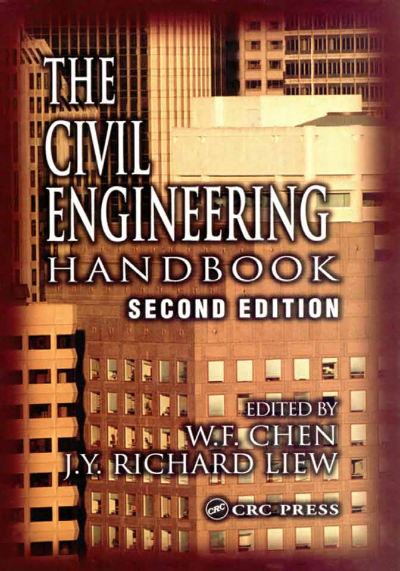Download The Civil Engineering Handbook Second Edition By W.F. CHEN And J. Y. Richard Liew Easily In PDF Format For Free.
The Second Edition Of The Civil Engineering Handbook Has Been Revised And Updated To Provide A Comprehensive Reference Work And Resource Book Covering The Broad Spectrum Of Civil Engineering. This Book Has Been Written With The Practicing Civil Engineer In Mind. The Ideal Reader Will Be A BS- Or MSclevel Engineer With A Need For A Single Reference Source To Use To Keep Abreast Of New Techniques And Practices As Well As To Review Standard Practices.
The Handbook Stresses Professional Applications, Placing Great Emphasis On Ready-To-Use Materials. It Contains Many Formulas And Tables That Give Immediate Solutions To Common Questions And Problems Arising From Practical Work. It Also Contains A Brief Description Of The Essential Elements Of Each Subject, Thus Enabling The Reader To Understand The Fundamental Background Of These Results And To Think Beyond Them. Traditional As Well As New And Innovative Practices Are Covered. As A Result Of Rapid Advances In Computer Technology And Information Technology, A Revolution Has Occurred In Civil Engineering Research And Practice.
A New Aspect, Information Technology And Computing, Has Been Added To The Theoretical And Experimental Aspects Of The Field To Form The Basis Of Civil Engineering. Thorough Coverage Of Computational And Design Methods Is Essential In A Knowledge-Based Economy. Thus, Computational Aspects Of Civil Engineering Form The Main Focus Of Several Chapters. The Civil Engineering Handbook Is A Comprehensive Handbook, Featuring A Modern CAD/CAE Approach In Advancing Civil Engineers In The 21st Century.
The Handbook Is Organized Into Eight Sections, Covering The Traditional Areas Of Civil Engineering: Construction Engineering, Materials Engineering, Environmental Engineering, Structural Engineering, Geotechnical Engineering, Surveying Engineering, Hydraulic Engineering, And Transportation Engineering. The Subdivision Of Each Section Into Several Chapters Is Made By The Associate Editors And Is Somewhat Arbitrary, As The Many Subjects Of The Individual Chapters Are Cross-Linked In Many Ways And Cannot Be Arranged In A Definite Sequence. To This End, In Addition To The Complete Table Of Contents Presented At The Front Of The Book, An Individual Table Of Contents Precedes Each Of The Eight Sections And Gives A General Outline Of The Scope Of The Subject Area Covered. Finally, Each Chapter Begins With Its Own Table Of Contents.
The Reader Should Look Over These Tables Of Contents To Become Familiar With The Structure, Organization, And Content Of The Book. In This Way, The Book Can Also Be Used As A Survey Of The Field Of Civil Engineering, By The Student Or Civil Engineer, To Find The Topics That He Or She Wants To Examine In Depth. It Can Be Used As An Introduction To Or A Survey Of A Particular Subject In The Field, And The References At The End Of Each Chapter Can Be Consulted For More Detailed Studies.
The Chapters Of The Handbook Have Been Written By Many Authors, All Experts In Their Fields, And The Eight Sections Have Been Carefully Edited And Integrated By The Various Associate Editors In The School Of Civil Engineering At Purdue University And The Department Of Civil Engineering At The National University Of Singapore. This Handbook Is A Testimonial To The Dedication Of The Associate Editors, The Publisher, And The Editorial Associates.
I Wish To Thank All Of The Authors For Their Contributions And The Reviewers For Their Constructive Comments. I Also Wish To Acknowledge At CRC Press, Helena Redshaw, Elizabeth Spangenberger, Susan Fox, And Cindy Carelli For Their Professional Support In Revising This Handbook.


Comments
Post a Comment